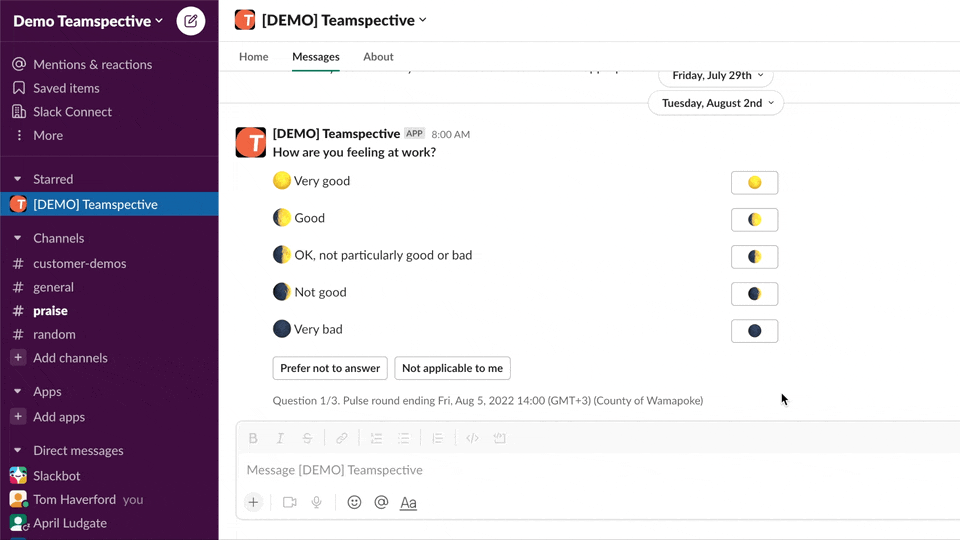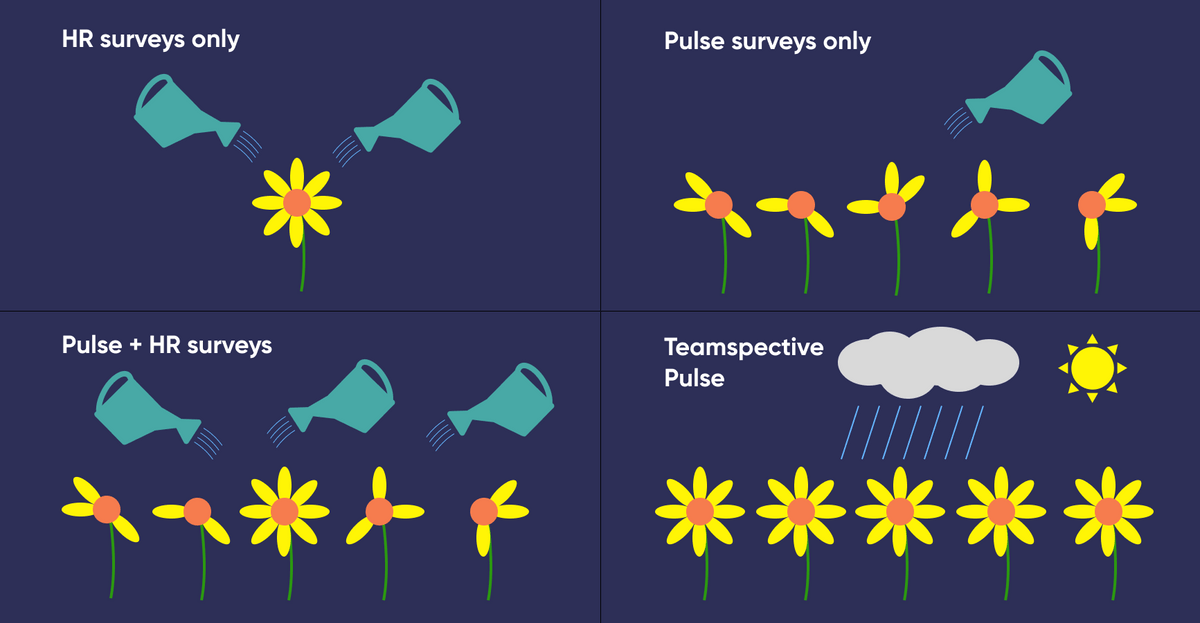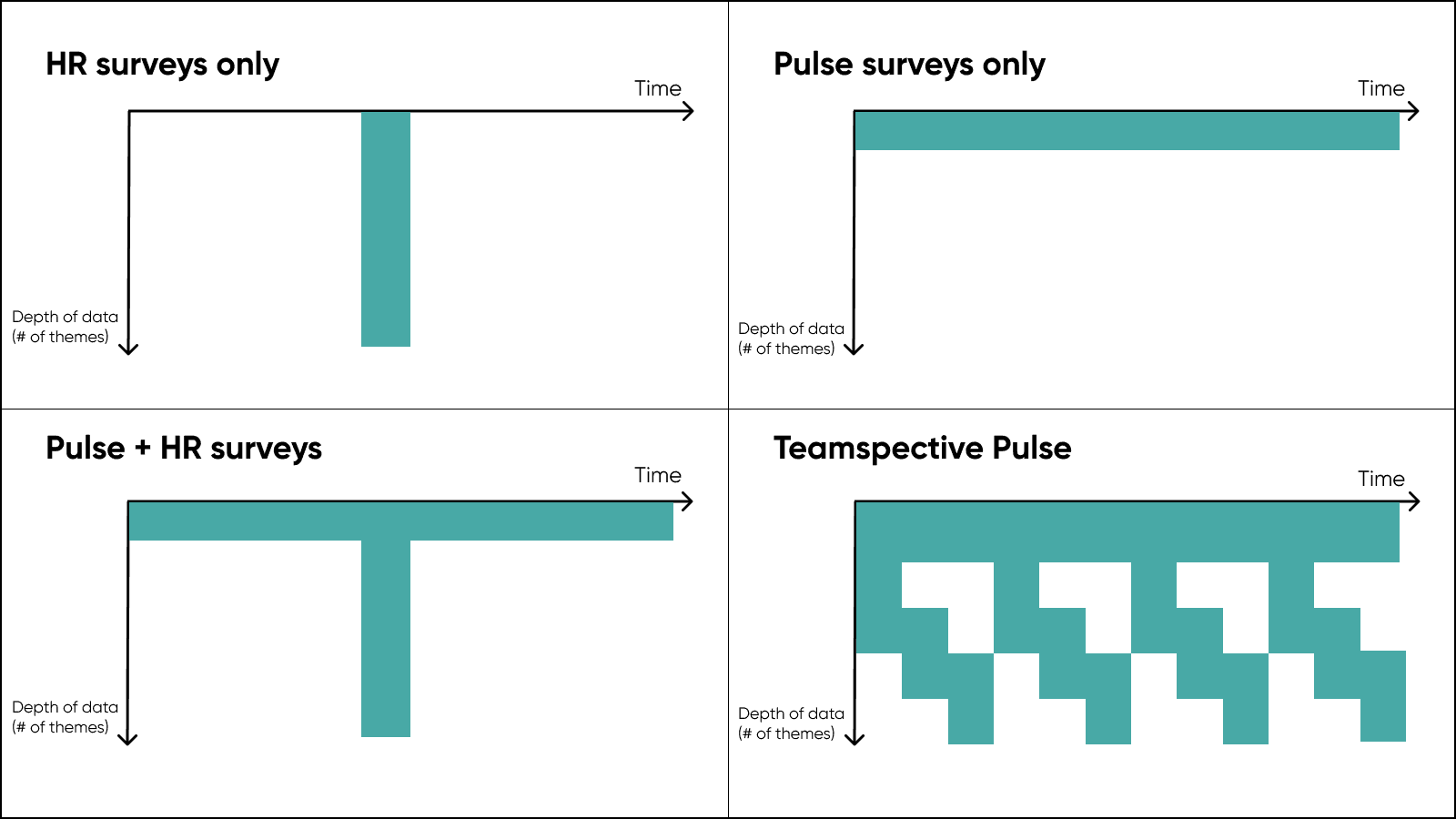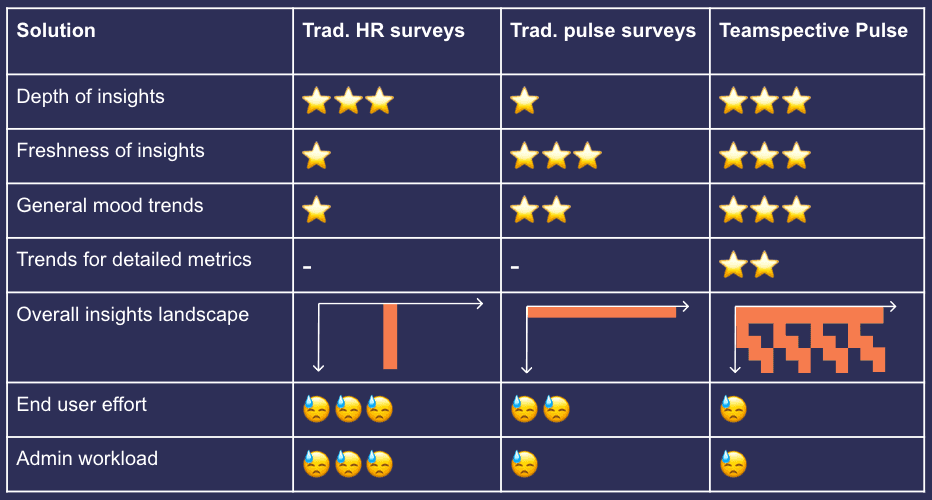Traditional Pulse Surveys: Real-time mood and trends
A pulse survey is a short and frequent survey that collects real-time feedback on employee engagement and satisfaction. They consist of a couple of questions, sometimes only one, and are conducted weekly, bi-weekly or monthly. Pulse surveys provide companies with quick insights into their employees' engagement and satisfaction levels, allowing them to track trends and notice quickly if something might be wrong.
Traditional HR/employee surveys: The annual tradition of asking about everything
The term “HR survey” usually refers to a more comprehensive survey that covers a range of topics related to HR, such as benefits, compensation, employee onboarding, and training and development. HR surveys are usually conducted annually or bi-annually and consist of several questions (usually 20 or more). The goal of HR surveys is to gather feedback from employees to HR about their overall experience and identify areas for improvement.
The Benefits and Disadvantages of Pulse Surveys
Benefits of Pulse surveys:
- Real-time insights: By collecting feedback on a more frequent basis, pulse surveys provide companies with timely insights that they can act on immediately.
- Seeing change: Frequent data allows tracking trends and seeing the impact of individual events or changes in company circumstances, which a bi-annual snapshot would likely miss completely.
- Employee engagement: By providing a platform for employees to voice their opinions, merely having pulse surveys in place may increase employee engagement and satisfaction.
Disadvantages:
- Repetitive: Typical pulse surveys that only consist of 1-5 repeating questions can become boring to answer.
- A continuous chore: If answering requires logging in to a separate system, it can feel to some employees like a persistent extra burden.
- Might feel useless: If employees don’t get their own teams’ results, it might not just become a chore but one that feels meaningless, which further reduces response rates and increases coordination overhead.
- Superficial insight: The provided insights from just a few questions are also fairly shallow, leaving the nature of the problems and their root causes unclear. This makes it harder to take effective action.
The Benefits and Disadvantage of HR Surveys
Benefits of Broader HR surveys over typical pulse surveys:
- Comprehensive feedback: HR surveys cover a range of topics related to HR, providing companies with a more comprehensive understanding of their employees' experiences.
- Benchmarking: Using a standardized survey structure may allow companies to benchmark their employee data against industry standards.
Disadvantages:
- A burdensome answering experience: Surveys with dozens of questions are very heavy for employees to fill in and often require a lot of nudging from HR and management.
- Admin workload: Aggregating and analyzing results can take weeks of admin work.
- Does not capture fast changes or trends: Though the insights might be deep (assuming you get to a high response rate), it’s still only a momentary snapshot. Trends and variance are hidden, and the data may be strongly biased by the timing of the survey.
Teamspective’s Pulse: The Best of Both Worlds
Considering the pros and cons listed above, in a perfect world, you would have:
- Deep, nuanced insights
- Measured multiple times per year to capture trends
- High response rates without a need to harass people
- Automatic visual reporting for all levels in the org
- Automatic guidance for taking action on the results
- Minimal effort and maximum direct benefits for the end users (your employees) as well as HR and management
Teamspective's advanced pulse surveys provide companies with the benefits of both pulse surveys and HR surveys. Our pulse surveys are short and easy to complete, consisting of a maximum of 6 questions at a time. Questions are rotated intelligently and automatically, so companies can collect feedback on a broad range of HR topics over time.
Unlike one big survey, the data is collected over time, making it more reliable (time diversification) and revealing trends also for more nuanced metrics.
However, shortness is not the only thing making them the Easiest Pulse Surveys in the World. Our pulse surveys work directly inside Slack and MS Teams, making it fast and convenient for employees to complete them without having to leave the team communication platform where other things are discussed and coordinated daily. Answering becomes a 30-second routine that can be done on the commute, even on an elevator ride. Click, click, click… and done.

Answering a Teamspective Pulse survey directly in Slack and adding a question-specific comment (always optional).
This low threshold increases response rates and provides companies with a more accurate picture of their employees' experiences, revealing the unique challenges and important focus areas for each team and unit. Our customers typically achieve 75% response rates.
As another unique feature, the engagement and wellbeing data from Teamspective’s pulse surveys can be combined with the network data from Teamspective’s cutting-edge Organizational Network Analysis solution, giving more context to the insights and letting you identify local issues as well as their root causes more effectively.
Conclusion
If you have any kind of pulse or employee survey in place, you are already way ahead of organizations that don’t collect anonymous employee feedback in any systematic way. Sustained organizational growth starts with listening to your people.
However, companies that care about their employee experience and culture typically tend to implement both pulse surveys and heavy annual HR surveys, often through separate platforms. The data can be hard to combine and each data set has its deficiencies: Either it’s shallow (pulse data) or an already-out-dated, unreliable snapshot (traditional HR survey results). The insights are at best “T-shaped”.
Teamspective's Pulse yields deep, continuous insights with minimal effort, by rotating question intelligently.
Teamspective offers a solution that provides the benefits of both, giving HR, management, and the teams themselves timely, nuanced insights and actionable feedback on a range of topics. There are also benefits that a combination of HR surveys and simple pulse surveys can’t provide, like seeing trends for multiple engagement & wellbeing metrics as well as flagging specific issues (with e.g. fairness, teamwork, psychological safety) in a timely manner before they escalate. The data doesn’t only cover a “T”, but the whole time-theme continuum.
Does it sound too good to be true?
Read more about our pulse survey on solution's page.
Book a demo with our experts directly here.
You can try the surveys for 2 rounds for free before making up your mind. Setup and rollout only takes a bit over an hour, regardless of whether you decide to test with your whole staff or a smaller group.
Read also: 4 Common Blockers to Implementing Pulse Surveys - What are you leaving on the table?



